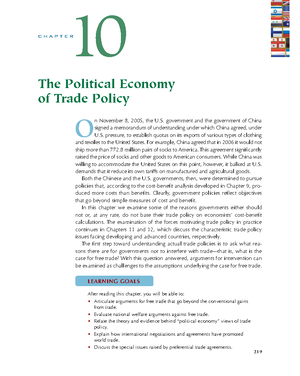- Information
- AI Chat
Was this document helpful?
Opportunity Cost Candonia and Desonia
Course: International Economics (DEL-BUSECO-015)
101 Documents
Students shared 101 documents in this course
University: University of Delhi
Was this document helpful?

Specialization and trade
When a country has a comparative advantage in the production of a good, it means that it can
produce this good at a lower opportunity cost than its trading partner. Then the country will
specialize in the production of this good and trade it for other goods.
The above graphs show the production possibilities frontiers (PPFs) for Candonia and
Desonia. Both countries produce potatoes and coffee, each initially i.e., before specialization
and trade) producing 18 million pounds of potatoes and 9 million pounds of coffee, as
indicated by the grey stars marked with the letter A.
Candonia has a comparative advantage in the production of potatoes, while Desonia has a
comparative advantage in the production of coffee. Suppose that Candonia and Desonia
specialize in the production of the goods in which each has a comparative advantage. After
specialization, the two countries can produce a total of 36 million pounds of potatoes and 36
million pounds of coffee.
Explanation:
As observed from the PPF for Candonia, it can produce either36 million pounds of potatoes
and 18 million pounds of coffee
Opportunity cost of 1 pound of potatoes = 18/36 = 0.5 pounds of coffee
Alternatively, opportunity cost of 1 pound of coffee = 36/18 = 2 pounds of potatoes
Similarly, we can calculate the opportunity cost of producing one pound of potatoes in terms
of pound of coffee. We summarize the opportunity costs in the following table
Opportunity Cost of 1 pound of
potatoes
Opportunity Cost of 1 pounds of coffee
Students also viewed
Related documents
- Int. Eco Unit 2 - International economics for business economics students for exams study material
- Int. Eco Unit 1 - International economics for business economics students for exams study material
- Indian Economics 1 Semester 5 Core Course
- Comparative advantage - input approach explanation with example
- International economics paper 2020 set A
- Chapter 4 Gondolfo - This reading is a new addition in the course for international trade in LOCF














